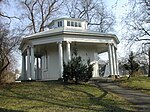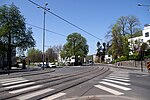Vigeland Museum

The Vigeland Museum (Norwegian: Vigelandmuseet) is a museum dedicated to Gustav Vigeland in Frogner, Oslo. It is located outside Frogner Park, which includes the Vigeland installation with sculptures by Gustav Vigeland. The museum is part of Oslo municipality's cultural department. The museum is dedicated to Norway's most famous sculptor, Gustav Vigeland (1869–1943). The museum is Vigeland's former studio and residence. His urn and ashes are located in the tower of the museum. He designed his own bronze urn and burial monument, located above his apartment on the 2nd floor. The official web site for the museum is: https://vigeland.museum.no/en . The Vigeland Museum celebrated Gustav Vigeland's 150th Year Anniversary in 2019. Until 2020 the museum used the spelling Vigeland-museet in Norwegian; the spelling was changed to Vigelandmuseet after a long period where people often spelled it Vigelandsmuseet (with s).
Excerpt from the Wikipedia article Vigeland Museum (License: CC BY-SA 3.0, Authors, Images).Vigeland Museum
Halvdan Svartes gate, Oslo Frogner
Geographical coordinates (GPS) Address Website External links Nearby Places Show on map
Geographical coordinates (GPS)
| Latitude | Longitude |
|---|---|
| N 59.92285 ° | E 10.70013 ° |
Address
Vigelandmuseet
Halvdan Svartes gate
0267 Oslo, Frogner
Norway
Open on Google Maps









